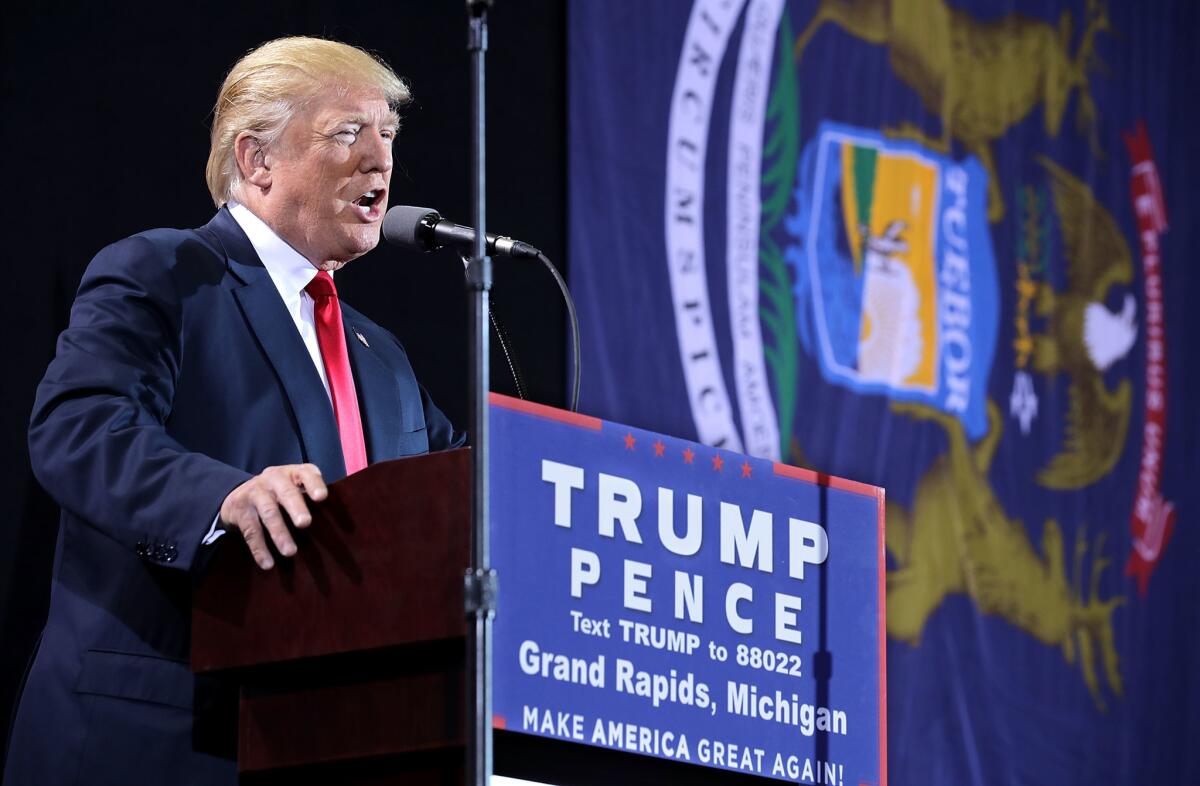Trump is placing a long-shot bet to win a handful of states. It could overturn the electoral map

Donald Trump addresses a campaign rally Monday in Grand Rapids, Mich.
Reporting from Eau Claire, Wis. — With one week before election day, Donald Trump spent the bulk of Tuesday campaigning in Wisconsin, a state that has not backed a Republican for president since 1984.
His unorthodox visit came on the heels of trips to Michigan and Pennsylvania, states that also haven’t gone red since the 1980s.
For the final stretch of the presidential race, the GOP nominee has embarked on a strategy of long-shot bids, holding rallies and airing ads in states that have been reliably Democratic in recent elections. Trump’s gambit sacrifices face time in battleground states, but if successful would upend the political map and likely hand him the White House.
“The Trump campaign is on the offensive and expanding our presence in battleground states into blue states,” David Bossie, Trump’s deputy campaign manager, told reporters Tuesday.
Trump’s campaign believes it can flip states by relying on his populist rhetoric that connects with white working-class voters hurt by the Rust Belt’s decline in manufacturing.
Michigan was among 13 states where the Trump campaign placed a $25-million ad buy for the final week of the race, digital director Brad Parscale announced. Pennsylvania and New Mexico, other mostly reliably blue states, were also on the list.
At a rally Monday in Warren, Mich., Trump seemed almost giddy as he repeatedly mentioned how a win in the state would buck historical precedent.
“No Republican has won since like Reagan or something many years ago” — it was actually George H.W. Bush — “and I said, ‘I love Michigan,’” he said.
Trump has made a number of high-profile visits to the state, and he has enthusiastic grass-roots groups such as the Michigan Conservative Coalition organizing flash mobs and knocking on doors on his behalf.
His campaign also has more than 30 offices in the state and consistently knocks on at least 100,000 doors a week, said Scott Hagerstrom, who runs Trump’s campaign in Michigan.
The biggest challenge, he said, is “to get people to believe again, to believe that it’s possible.”
Trump faces steep hurdles in Michigan, Pennsylvania and here in Wisconsin, a state that has voted Democratic since 1984. He trails in public polls by 5 to 6 points in those states, according to averages maintained by RealClearPolitics.
But if the race tightens significantly, the time invested in those states may yield dividends.
“The campaigns are interested in potential tipping-point states if the race closes to 50-50 nationally, not just where they are in the polls right now,” said Matt Grossmann, director of the Institute for Public Policy and Social Research at Michigan State University. “In a closer national race, Michigan should be competitive.”
Late-autumn encroachment on rival territory is not unique to Trump. Past elections also have seen eleventh-hour maneuvers, such as then-GOP nominee Mitt Romney making an incursion into Pennsylvania two days before the 2012 election and George W. Bush visiting California just before the 2000 vote.
Democratic nominee Hillary Clinton is making her own efforts to pick off typically red states, particularly Arizona. She’ll hold a rally in Tempe on Wednesday, and running mate Tim Kaine will give a speech entirely in Spanish in Phoenix on Thursday.
Campaign manager Robby Mook called Arizona a “battleground state” based on internal analysis of early-voting data and voter registration trends.
“What I would like to call ‘the Hillary coalition’ is starting to emerge,” Mook said, adding Republican women to an electorate that mirrors what has been referred to as the Obama coalition of minority, young and independent voters.
Clinton is also shoring up support in states that had seemed securely in her column, expanding advertising in Virginia and Colorado while airing ads in New Mexico and Michigan for the first time in the general election. She’ll also campaign in Detroit on Friday.
Trump advisors pounced on the moves as signs of trouble for Clinton, though her aides cast them as an effort to spend all of the campaign’s resources.
“We were able to raise a good amount of money and we’d like to spend it. It’s the last week to spend,” said a senior Clinton campaign official, who would not be named discussing electoral strategy.
The campaign had anticipated that the polls would tighten, the aide argued, adding that internal polling showed no great impact yet from the FBI announcement that it was reviewing newfound emails for possible links to Clinton’s private server.
Bossie said he was heartened that Clinton was spending money in Democratic states.
“She is on the defense,” he said.
Data on early voting underscore the trade-offs the candidates face in choosing where to put time and money.
So far, Latino voters appear to be turning out at levels above 2012 — far greater in some states. But African American voters have lagged behind.
That puts Clinton in a stronger position in states where Latinos play a key role, notably Arizona and Nevada. It could indicate trouble in Industrial Belt states, where a big turnout by black voters was crucial to President Obama’s victories.
Obama won in Ohio in 2012 because of “tremendous performance out of Cuyahoga County and Franklin County” by African American voters, said Democratic pollster Cornell Belcher, referring to the counties that include Cleveland and Cincinnati.
“But 2012 was an amazing year for African American voters,” he added. The question for Democrats will be how much of a decline they suffer.
That decline in black turnout is part of the reason public polls show Trump well-positioned to capture Ohio. His strong support from blue-collar white voters has also given him a potential edge in Iowa, another archetypal swing state that Obama won twice.
Clinton is nurturing the traditional swing states. Every day this week, either she or a top-flight surrogate will campaign in North Carolina, a state Obama carried narrowly in 2008 only to see it flip barely to the Republican column in 2012.
On Monday, Clinton made her ninth stop in Ohio since the Democratic National Convention. She’ll return there by week’s end after her second stop of the week in Florida, where she campaigned Tuesday.
“Florida can decide who our next president is,” Clinton said at a rally in Dade City.
The early vote so far shows Florida could be headed to yet another extremely close result, cementing its status as the nation’s most closely divided battleground.
“It’s close here. l could make an argument for either one of them here right now, very easily,” said Democratic strategist Steve Schale, who ran Obama’s campaign in Florida in 2008.
As in other states, early voting by black voters in Florida has lagged behind their 2012 share of the electorate, which is why Obama will be traveling this week to Miami and Jacksonville to campaign for Clinton.
“We need the number to go up,” Schale said. “Having the president here helps.”
Mason reported from Eau Claire and Memoli from Dade City, Fla. Times staff writers David Lauter in Washington and Seema Mehta in Los Angeles contributed to this report.
Twitter: @melmason, @mikememoli
FBI speeds up its investigation into possible Clinton-related emails after criticism
Deep in the heart of Texas, Trump has Republicans worried about losing a congressional seat
UPDATES:
4:55 p.m.: This story was updated with Clinton and Trump rallies and comments from both campaigns.
8:55 a.m.: This story was updated with the Trump campaign adding Pennsylvania to the states where it is applying an ad buy in the last week of the election.
This story was originally published at 8:40 a.m.
More to Read
Get the L.A. Times Politics newsletter
Deeply reported insights into legislation, politics and policy from Sacramento, Washington and beyond. In your inbox three times per week.
You may occasionally receive promotional content from the Los Angeles Times.












